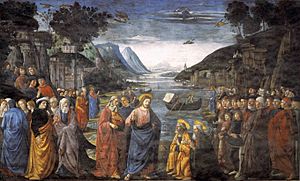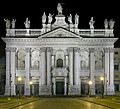Twelve Apostles facts for kids

The Twelve Apostles, (somebody sent forth/sent out) were men who, according to the Synoptic Gospels and Christian tradition, were chosen from among the disciples (students) of Jesus Christ for a mission. Judaism had an office known as apostle (שליח)".
The Gospel of Mark states that Jesus Christ initially sent out these twelve in pairs , to towns in Galilee.
Contents
Twelve Apostles
According to the list occurring in each of the Synoptic Gospels (Mark 3:13-19, Matthew 10:1-4, Luke 6:12-16), the Twelve chosen by Jesus near the beginning of his ministry, those whom also He named Apostles, were
- Simon: called Peter (Grk. petros, petra; Aram. kēf; Engl. rock) by Jesus of Nazareth, also known as Simon bar Jonah and Simon bar Jochanan (Aram.) and earlier (Pauline Epistles were written first) Cephas (Aram.), and Simon Peter, a fisherman from Bethsaida "of Galilee" (John 1:44; cf. 12:21) Simon/Peter - Andrew's brother (Matthew 10:2; Mark 3:16; Luke 6:14)
- Andrew: brother of Peter, a Bethsaida fisherman and disciple of John the Baptist, and also the First-Called Apostle. (Matthew 10:2; Mark 3:18; Luke 6:14)
- James - John's brother, son of Zebedee, Boanerges, son of Thunder (Matthew 10:2; Mark 3:17; Luke 6:14)
- John son of Zebedee, called by Jesus Boanerges(an Aramaic name explained in Mk 3:17 as "Sons of Thunder") - James' brother (Matthew 10:2; Mark 3:17; Luke 6:14)
- Known as the only apostle who was not martyred, and also has his own Gospel in the New Testament.
- Philip: from Bethsaida "of Galilee" (John 1:44, 12:21) (Matthew 10:3; Mark 3:18; Luke 6:14)
- Thaddeus: "Judas, son of James", (Matthew 10:3, Acts 1:13, Luke 6:16, John 14:22). Lebbaeus/Judas/Juda - , Simon's brother (Matthew 10:3; 13:55; Mark 3:18; 6:3; Luke 6:16; Jude 1:1)
- Bartholomew: in Aramaic "bar-Talemai?", "son of Talemai" or from Ptolemais, some identify with Nathanael. (Matthew 10:3; Mark 3:18; Luke 6:14)
- Thomas: also known as Judas Tomas Didymus - Aramaic T'oma = twin, and Greek Didymous = twin (Matthew 10:3; Mark 3:18; Luke 6:15)
- James: commonly identified with James the Less - Matthew's/Levi's brother, son of Alphaeus (Matthew 10:3; 27:56; Mark 2:14; 3:16, 18; 6:3; 15:40, 47; Luke 5:27; 6:14-15; 24:18; Acts 1:13; 4:36).
- Matthew: the tax collector, some identify with Levi son of Alphaeus - Levi - James' brother (James the less) (Matthew 10:3; 27:56; Mark 2:14; 3:16, 18; 6:3; 15:40, 47; Luke 5:27; 6:14-15; 24:18; Acts 1:13; 4:36) and author of the Book of Matthew
- Simon the Canaanite: called in Luke and Acts "Simon the Zealot", some identify with Simeon of Jerusalem -, Thaddeus' brother (Matthew 10:4; 13:55; Mark 3:18; 6:3; Luke 6:15)
- Judas Iscariot: the name Iscariot may refer to the Judaean towns of Kerioth or to the sicarii (Jewish nationalist insurrectionists), or to the tribe of Issachar; (Matthew 10:4; Mark 3:19; Luke 6:16)
- He was replaced as an apostle in Acts by Saint Matthias
| Major events in Jesus's life in the Gospels |
|---|
|
It should also be noted that while the "Twelve Apostles" refer to the twelve who followed Jesus during his lifetime (and later Matthias in place of Judas Iscariot), Paul (formerly Saul of Tarsus) can be considered as another apostle. Notably, he begins many of his epistles with "Paul, an apostle of Christ Jesus", or some variant. The original twelve were apostles sent out to the Jews, whereas Paul has the unique role of being the apostle to the gentiles after Christ's resurrection and ascent.
The identity of the other apostle of the twelve, traditionally called St. Jude, varies between the Synoptic Gospels and also between ancient manuscripts of each gospel:
- Mark names him as Thaddaeus
- Some manuscripts of Matthew also identify him as Thaddeus
- Some manuscripts of Matthew name him as Lebbaeus
- Some manuscripts of Matthew name him as Judas the Zealot
- Luke names him as Judas, son of James or in the KJV: "Judas the brother of James"]] Luke 6:16
The Gospel of John, unlike the Synoptic Gospels, does not offer a formal list of apostles, but does refer to the Twelve in 6:67, 6:70, and 6:71. The following nine apostles are identified by name:
- Peter (Bowen)
- Andrew (identified as Peter's brother)
- the sons of Zebedee (plural form implies at least two apostles)
- Philip
- Thomas (also called Didymus (11:16, 20:24, 21:2))
- Judas Iscariot
- Judas (not Iscariot) (14:22)
The individual that the Gospel of John names as Nathanael is traditionally identified as the same person that the Synoptic Gospels call Bartholomew, and most would agree that the sons of Zebedee is likely to be a reference to James and John, while Judas (not Iscariot) probably refers to Thaddaeus, also known as St. Jude. Noticeably missing from the Gospel of John are James, son of Alphaeus, Matthew, and Simon the Canaanite/Zealot.
The Disciples of Jesus Christ
| Name | Details | Matthew | Mark | Luke | John | Acts | Jude | James |
|---|---|---|---|---|---|---|---|---|
| Simon Peter | Andrew's Brother, Cephas in Latin meaning "The Rock," | 10:2 | 3:16 | 6:14 | 1:35-42 | |||
| Andrew | Simon Peter’s Brother, disciple of John the Baptist | 10:2 | 3:18 | 1:35-42; 6:14 | ||||
| James | John's Brother, son of Zebedee and Salome, Bornerges, Son of Thunder, nephew of Joseph and Mary, cousin of Jesus | 10:2; 20:20; 27:56; | 3:17; 15:40; 16:1; | 6:14; | 19:25; | |||
| John | James' Brother, son of Zebedee and Salome, Bornerges, Son of Thunder, nephew of Joseph and Mary, cousin of Jesus | 10:2; 20:20; 27:56; | 3:17; 15:40; 16:1; | 6:14; | 19:25; | |||
| Philip | from Bethsaida "of Galilee" | 10:3; | 3:18; | 6:14; | 1:44; 12:21; | |||
| Bartholomew Nathaniel | 10:3; | 3:18; | 6:14; | 1:43-51; | ||||
| Matthew Levi | Son of Alphaeus, James the Less, Jude, and Simon. | 10:3; 27:56; | 2:14; 3:16,18; 6:3; 15:40,47; | 5:27; 6:14-15; 24:18; | 1:13; 4:36; | |||
| Thomas | Didymus - which means "the Twin" | 10:3; | 3:18; | 6:15; | 20:24-29 | |||
| James the Less | The son of Alphaeus and Thaddaeus (not to be confused with James The Just, who only became an apostle after Jesus' resurrection) | 10:3; 27:56; | 2:14; 3:16,18; 6:3; 15:40,47; | 5:27; 6:14-15; 24:18; | 1:13; 4:36; | 1:1; | ||
| Thaddaeus Lebbaeus Judas Juda Jude | Son of James - so probably not Jesus' Half-Brother | 13:55; | 3:18; 6:3; | 6:16; | 1:1; | |||
| Simon Zelotes | Simon the Zealot is not associated in the Gospels with Jesus' Half-Brother, Simon | 10:4; 13:55; | 3:18; 6:3; | 6:15; | ||||
| Judas Iscariot | the Traitor: Betrayed Jesus for thirty pieces of silver, later hanged himself | 10:4; | 3:19; | 6:16; | ||||
| Matthias | Disciple of John the Baptist, replacement for Judas Iscariot | 1:35-42; | 1:20-26; |
Relics and burial sites
Relics of the apostles are claimed by various churches, many in Europe.
- Andrew: buried in Cathedral of Saint Andrew, Patras, Greece
- Bartholomew: buried in the Basilica of Benevento, Italy, or Basilica of St. Bartholomew on the Island, Rome, Italy
- James the Great: buried in Santiago de Compostela Cathedral in Santiago de Compostela, Galicia, Spain
- James, son of Alphaeus: buried in the Cathedral of St. James in Jerusalem or the Church of the Holy Apostles in Rome.
- John: no relics. The opening of his tomb (in the Basilica of St. John, Ephesus) during Constantine the Great's reign yielded no bones, giving rise to the belief that his body was assumed into heaven.
- Judas Iscariot: buried at Akeldama near Jerusalem (per the Gospel of Matthew and Acts of the Apostles).
- Jude Thaddeus: buried in St. Peter's Basilica under the St. Joseph altar with St. Simon the Zealot; two bones (relics) located at National Shrine of St. Jude in Chicago; other relics claimed by Reims Cathedral and Toulouse Cathedral.
- Matthew: buried in the Salerno Cathedral, Italy.
- Matthias: buried in the St. Matthias' Abbey in Trier, Germany.
- Paul: relics located in the Basilica of Saint Paul Outside the Walls in Rome; the skull located in the Archbasilica of Saint John Lateran, alongside the skull of St. Peter.
- Peter: buried in St. Peter's Basilica in Vatican City, Rome, Italy; the skull located in the Archbasilica of Saint John Lateran, alongside the skull of St. Paul.
- Philip: buried in the Church of the Holy Apostles in Rome or possibly Hierapolis, modern Turkey.
- Simon the Zealot: buried in St. Peter's Basilica in Rome under the St. Joseph altar with St. Jude.
- Thomas: buried in the San Thome Basilica in Chennai, India or in the Basilica of St. Thomas the Apostle in Ortona, Italy.
Legacy
By the 2nd century AD, association with the apostles was esteemed as an evidence of authority. Churches that are believed to have been founded by one of the apostles are known as apostolic sees.
Paul's epistles were accepted as scripture, and two of the four canonical gospels were associated with apostles, as were other New Testament works. Various Christian texts, such as the Didache and the Apostolic Constitutions, were attributed to the apostles. The Apostles' Creed, popular in the West, was alleged to have been composed by the apostles themselves.
Bishops traced their lines of succession back to individual apostles, who were said to have dispersed from Jerusalem and established churches across great territories. Christian bishops have traditionally claimed authority deriving, by apostolic succession, from the Twelve Apostles.
Early Church Fathers who came to be associated with apostles – such as Pope Clement I with St. Peter – are referred to as the Apostolic Fathers.
Images for kids
-
Jesus and the Twelve Apostles in Domus Galilaeae, Israel.
See also
 In Spanish: Apóstoles en el Nuevo Testamento para niños
In Spanish: Apóstoles en el Nuevo Testamento para niños
- Apostle (Latter Day Saints)
- Apostles' Fast
- Companions of the Prophet
- Council of Jerusalem
- Council of Twelve Apostles
- Equal-to-apostles
- Quorum of the Twelve
- Quorum of the Twelve Apostles (LDS Church)






